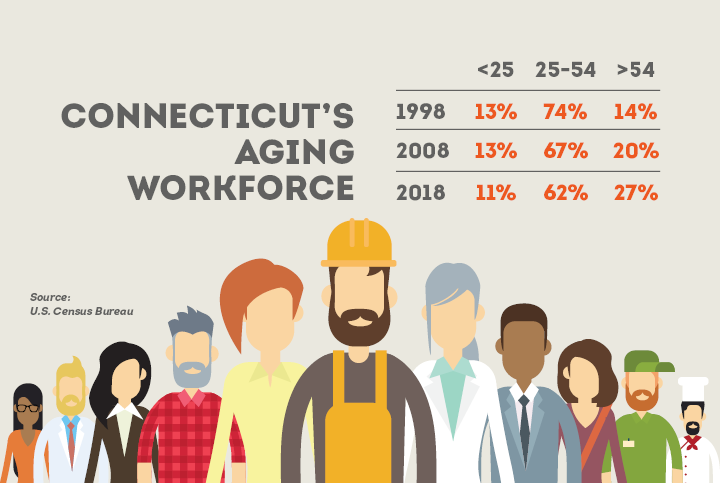State’s Aging Workforce Challenges Employers Across Industries

Connecticut’s workforce is growing older and grayer, impacting industries across the state according to a new government report.
The latest The Connecticut Economic Digest, published monthly by the state’s labor and economic development agencies, highlights this growing challenge.

In 1998, 13% of the state’s labor force was under the age of 25, 74% were aged 25-54—considered the prime age for working—and just 14% were over 54.
By 2018, 11% of the state’s workforce was under 25, 62% were aged between 25 and 54, and 27% were over 54.
In other words, over the last two decades, the state’s prime age workforce declined 13% while the 54-plus age bracket almost doubled.
“All industries are affected by population changes, but some are facing particular challenges as a larger proportion of the workforce is nearing retirement age,” the report’s authors wrote.
Heightened Need
Prime age employment ranges from 52% to 70% for all industry sectors, with declines in all expect accommodation and food services over the last 10 years.
Finance and insurance (70%), professional, scientific, and technical services (69%), and information (68%) have the highest concentrations of workers aged between 25 and 54.
A large share of the workforce is approaching retirement age, heightening the need for replacement workers.
“Connecticut has a highly skilled and experienced workforce, 42% of which have at least a college degree compared to 37% nationally,” the report notes.
“However, the increasing portion of older workers also indicates that a large share of the workforce is approaching retirement age, heightening the need for replacement workers in coming decades.”
Manufacturing Impact
And one industry likely to be hit hard by this trend is manufacturing.
Over the past 10 years, the 54-plus age bracket increased to 35% of the manufacturing workforce, well above the state average for all industries.
Manufacturing also experienced the largest decrease in prime age employment, down 38,000 over the last 10 years.
Over the past 10 years, the 54-plus age bracket increased to 35% of the manufacturing workforce.
However, manufacturing employment has grown more than 2% since hitting a low in 2016, a notable shift driven by growing demand in the defense and aerospace sectors.
“Manufacturing will need to hire many replacement workers in addition to filling the new jobs that are expected to be added in the short term,” the study noted.
‘Keeps Me Up At Night’
These trends are not lost on Connecticut manufacturers.
In his keynote speech this spring at CBIA’s Connecticut Economic Update, Pratt & Whitney CEO Bob Leduc said a lack of skilled workers “is the one thing that keeps me up at night.”
Between retirements and growth, Pratt will need 8,000 new hires in Connecticut in the next 10 years, 30% of them in manufacturing, Leduc said.
“My biggest concern is people,” he said. “Am I going to be able to find enough qualified people to grow this business and thrive in this state?
“When I talk to some of our suppliers, they express the exact same concern.”
Overall Employment Declines
Almost every industry sector experienced growth in the plus-54 workforce over the last two decades.
Manufacturing saw an 11 point increase in the last decade alone, while educational services rose to 31%.
“Educational services growth has been hindered by the declining population of school-age children, but the large share of workers over 54 in that sector indicates that many replacement workers will be needed even amid overall employment declines,” the report said.
By 2026, the labor force participation rate for those over age 65 is expected to be nearly double its 1996 level.
Connecticut has recovered just 80% of all jobs lost during the 2008-2010 recession.
The manufacturing and educational services sectors employ 25% of all over 54 workers, compared with 20% of the state’s overall workforce.
Healthcare, the state’s largest employment sector, employs 71,300 workers aged over 54—up 20,000 since 2008—the most of any industry.
Workforce Pipeline
The report calls for enhanced workforce development efforts, particularly in sectors hit hardest by the growth in workers aged over 54.
“As this age cohort grows in Connecticut, knowing which industries have a large share of these highly experienced workers is important to ensure that their needs are met and that an adequate pipeline exists to help train incoming workers to replace those who will eventually retire,” the study said.
It also means that many people over the age of 65 will continue to participate in the workforce in the coming years.
“Nationally, by 2026 the labor force participation rate for those over age 65 is expected to be nearly double its 1996 level,” the study said.
“In addition to preparing to replace retired workers, industries will need to accommodate older workers.”
RELATED
EXPLORE BY CATEGORY
Stay Connected with CBIA News Digests
The latest news and information delivered directly to your inbox.


